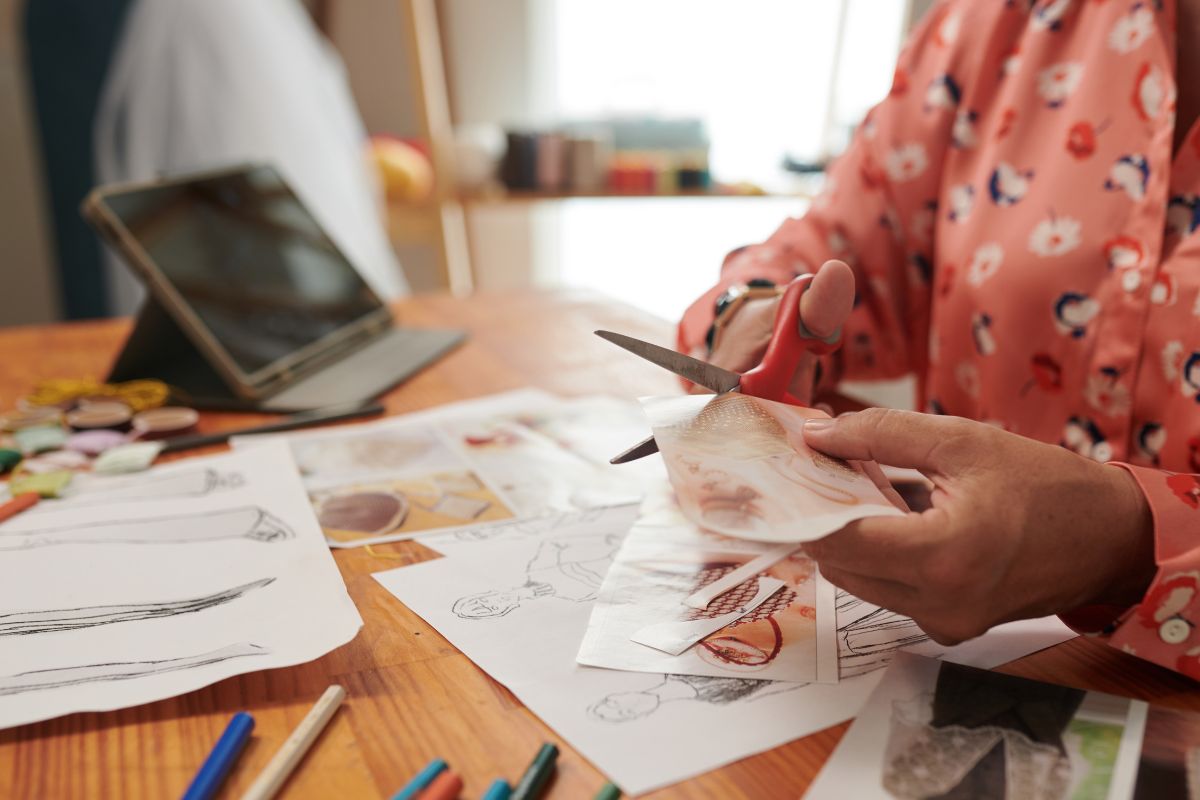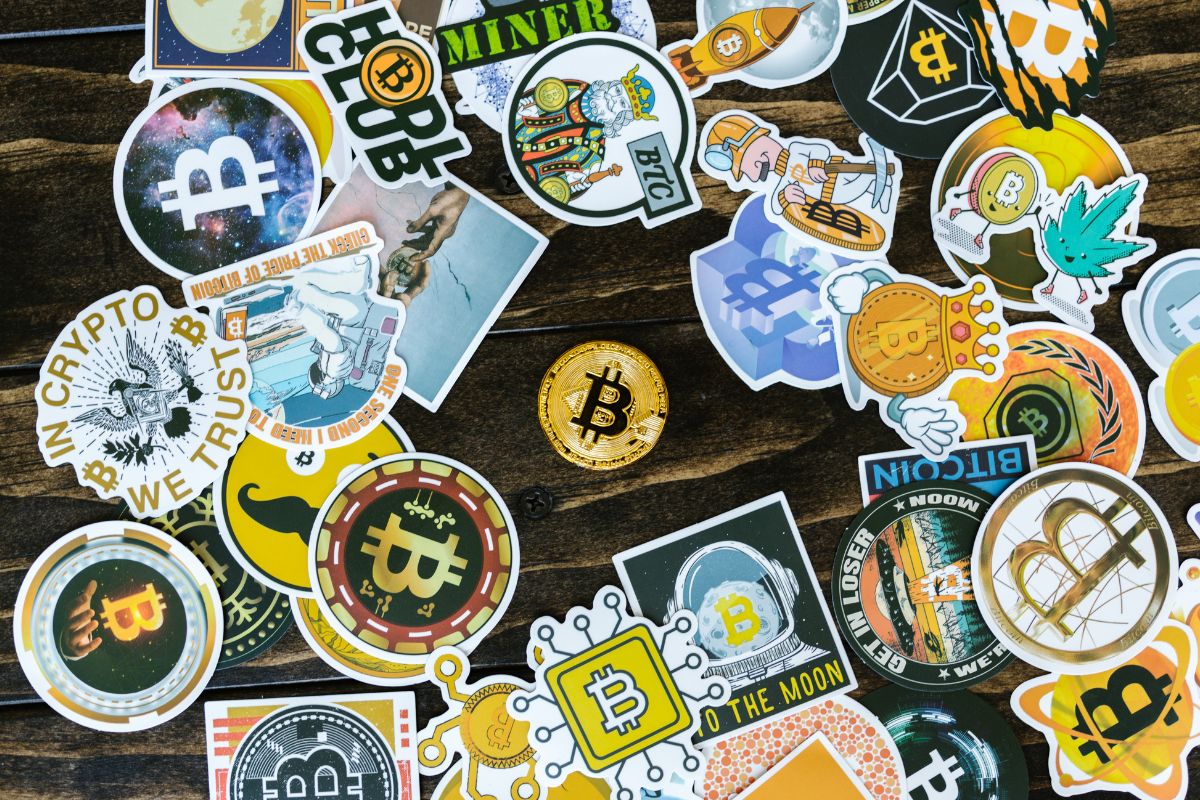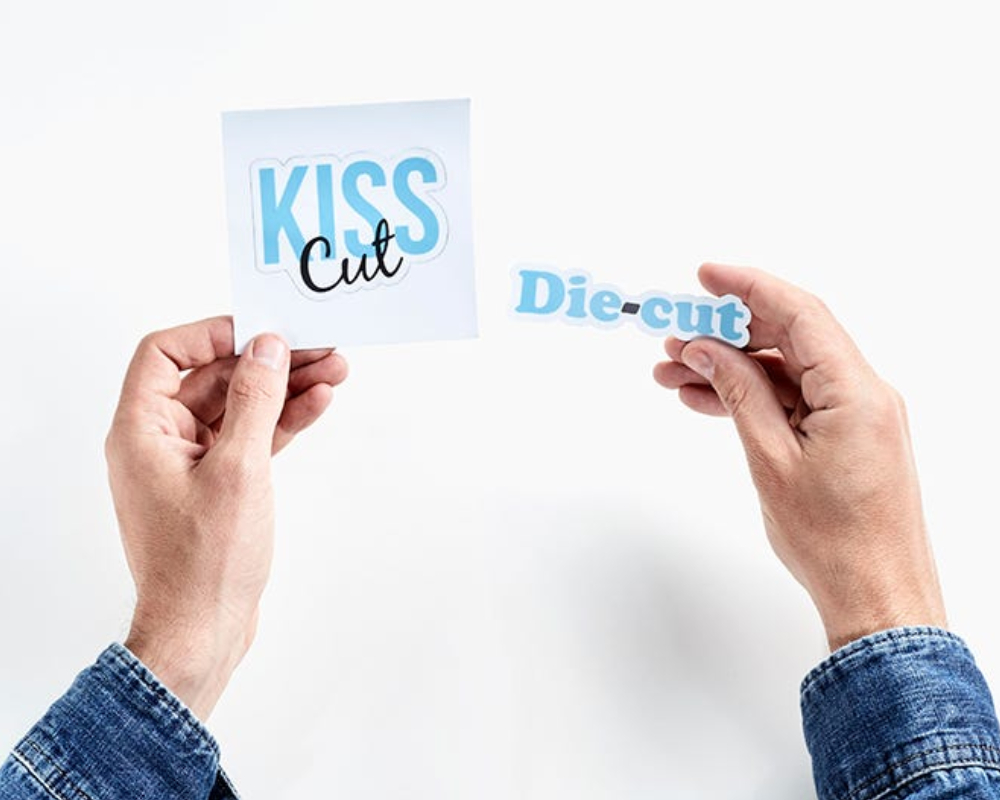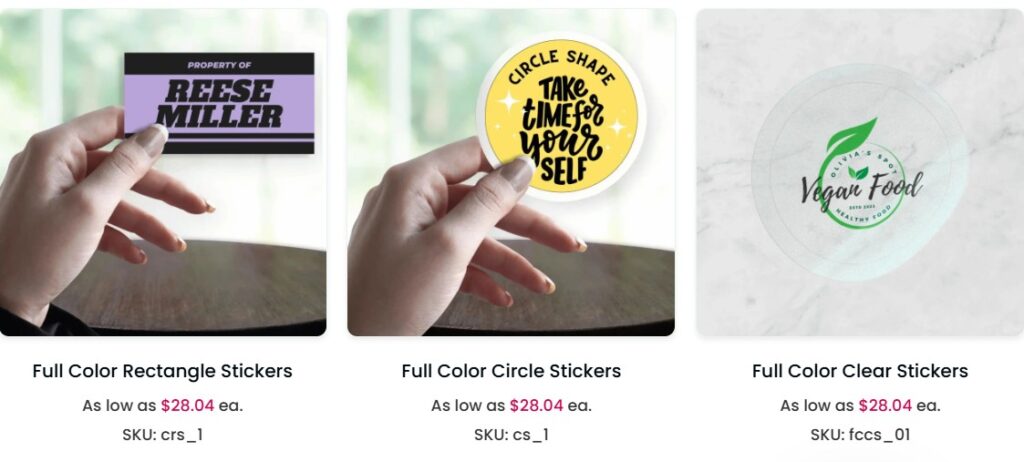When choosing between die cut and kiss cut stickers for your branding needs, it’s essential to understand the key differences.
Die cut stickers are cut through all layers, creating a specific shape with a clean, professional look, while kiss cut stickers only cut the top layer, allowing for easier peeling and application.
This choice can greatly impact how your designs are perceived and how effectively they stick to surfaces.
Comprehensive Table of Contents for Die-Cut and Kiss-Cut Stickers
- Understanding Die Cut and Kiss Cut Stickers
- Design Considerations
- Manufacturing Techniques
- Material and Finish Options
- Practical Applications
- Economic Considerations
- Advantages and Limitations
- Decision Criteria
- Frequently Asked Questions
- What are the primary differences between die cut and kiss cut stickers?
- How do the production processes for die cut and kiss cut stickers differ?
- Are there advantages to selecting either die cut or kiss cut for custom stickers?
- What are the usage scenarios for die cut stickers versus kiss cut stickers?
- How do transfer cut methods compare to die cut and kiss cut techniques?
- What should be considered when choosing between die cut and kiss cut for a project?
Kiss cut stickers are ideal for intricate designs that require careful handling, making them a great option for detailed branding elements.
On the other hand, die cut stickers offer a seamless finish that enhances the visual appeal, making them suitable for bold marketing messages. Understanding these options will help you select the best type of sticker to represent your brand effectively.
Whether you’re a small business owner or a marketer, using the right type of sticker can elevate your promotional efforts.
Knowing the advantages of both die cut and kiss cut stickers lets you make informed decisions that can enhance your marketing strategy and leave a lasting impression on your audience.
Understanding Die Cut and Kiss Cut Stickers
Die-cut and kiss-cut stickers are important tools in marketing and branding. Each type has unique features that suit different needs. Knowing the differences can help you choose the best option for your projects.
Definitions and Differences
Die-cut stickers are cut through both the sticker material and the backing paper. This type creates a shape that matches your design precisely, offering a clean and polished look. They are perfect for showcasing your brand’s logo or graphic without any extra borders.
Kiss-cut stickers, on the other hand, are cut only through the vinyl material, leaving the backing intact. This design creates a border around the sticker, making it easy to peel off. Kiss-cut stickers are often chosen for complex designs, as they provide more handling protection during application.
| Feature | Die-Cut Stickers | Kiss-Cut Stickers |
|---|---|---|
| Cut Depth | Through vinyl and backing | Through vinyl only |
| Design Presentation | Clean, shape of the design | With a border around |
| Application Ease | May need care for handling | Easier to peel |
Applications in Marketing and Branding
Die-cut stickers are popular for product labels and promotional materials. Their custom shapes can attract attention and enhance brand recognition. These stickers work well for outdoor use, as they are durable and ensure your logo stands out.
Kiss-cut stickers are ideal for giveaways and branding materials. They allow you to create multiple smaller stickers from one design, which increases versatility. This can be effective at events or as part of a marketing campaign, providing a fun way for customers to engage with your brand.
Both types serve different purposes, so consider your goals when choosing between them.
Design Considerations
| Feature | Die Cut Stickers | Kiss Cut Stickers |
|---|---|---|
| Cut Style | Fully cut through the vinyl and backing paper. | Only the sticker is cut, leaving the backing intact. |
| Appearance | Individual stickers in custom shapes. | Stickers come on a larger backing sheet. |
| Peel & Application | Requires peeling from the edges. | Easier to peel due to intact backing. |
| Durability | More durable due to thicker edges. | Similar durability but can have a thinner border. |
| Best for | Branding, standalone designs, product labels. | Bulk orders, easy-peel designs, promotional stickers. |
| Cost | Slightly more expensive. | Generally cheaper for bulk printing. |
| Customization | Fully customizable shape. | Customizable but usually with extra border space. |
| Common Uses | Laptop stickers, water bottles, event giveaways. | Sticker sheets, easy-peel product labeling. |
When you plan your sticker design, think carefully about complexity and visual appeal. The type of cut can impact how your stickers look and how they are used.
Design Complexity and Visual Appeal
Die-cut stickers allow for intricate designs and unique shapes. This type lets you create stickers that match almost any form, which can make your brand stand out. For example, logos with detailed edges or custom shapes can grab attention.
Kiss-cut stickers, on the other hand, are easier to handle. The outer layer is cut, leaving a border. This border can enhance the visual appeal by framing the design. It makes peeling the sticker off simple, which could be a big plus for users.
Choosing Between Die Cut and Kiss Cut for Unique Shapes
If your design features complex details or unique outlines, die-cut stickers are a better choice. They enhance the creativity of your project, letting you break away from traditional shapes.
In contrast, kiss-cut stickers are perfect for sticker sheets. They work well for multiple smaller designs. This option gives flexibility in how stickers are displayed and used, making them suitable for giveaways and promotions.
Consider your target audience and how you want them to interact with your stickers when making your choice.
Manufacturing Techniques

Understanding the different manufacturing techniques is essential for choosing the right cutting method for your project. Each technique offers unique benefits and uses that can affect the final product.
Die-Cutting Process
The die-cutting process uses a sharp metal die to create precise cuts through materials. This technique is ideal for producing specific shapes and designs.
During this process, sheets of raw material pass through a factory press where the metal die applies pressure. The die cuts all the way through the material and backing, resulting in individual pieces ready for use.
Key features of die-cutting include:
- Accurate Shapes: The sharp die ensures clean, accurate shapes.
- Variety of Materials: You can use this process on materials like paper, vinyl, and cardboard.
- Efficiency: Die-cutting is fast and suitable for large production runs.
This method is great for standalone stickers or products that don’t need backing support.
Kiss-Cutting Technique
Kiss-cutting is a softer cutting technique that only penetrates the top layer of the material. This leaves the backing paper intact, which is useful for easier handling and peeling.
In kiss-cutting, the cutting tool lightly presses down to create a contour cut. This design keeps the shapes organized on a single sheet, making it perfect for sticker sheets or bulk labels.
Key features include:
- Easy Peeling: Since the backing remains intact, stickers are easy to remove.
- Less Waste: This method reduces material waste compared to die-cutting.
- Creative Layouts: You can fit multiple designs on a single sheet, maximizing space.
Kiss-cutting is ideal for intricate designs that benefit from the support of the backing.
Material and Finish Options
When selecting materials and finishes for your stickers, you want to consider durability and visual appeal. The right choices enhance the functionality and aesthetic of your stickers, whether they are kiss-cut or die-cut.
Choosing the Right Material
For high-quality stickers, vinyl is the most popular choice due to its durability and resistance to weather. It is ideal for outdoor use and can last for years without fading.
If you’re creating sticker sheets, a flexible vinyl works well, allowing for easier application.
Other materials include paper and polyester, which may be suitable for indoor use or short-term applications.
Always consider the purpose of your stickers and select a material that aligns with where and how they will be used.
Finish Types for Enhanced Appeal
Finishes can dramatically change the look and feel of your stickers. A matte finish gives your stickers a smooth, non-reflective surface that produces a professional appearance. It reduces glare and is ideal for a subtle design.
On the other hand, a gloss finish provides a shiny look that brightens colors and makes them pop. It is great for vibrant designs and adds a protective layer.
You can also choose a laminate option, which enhances durability and scratch resistance, perfect for stickers that will be handled often.
Selecting the right finish depends on your design goals and how the stickers will be displayed.
Practical Applications
| Use Case | Die Cut Stickers | Kiss Cut Stickers |
|---|---|---|
| Branding & Logo Stickers | Ideal for handing out as individual stickers with a clean look. | Better for bulk giveaways with multiple stickers on a sheet. |
| Product Packaging | Used as premium labels for high-end products. | Common for easy-peel product labels. |
| Promotional Giveaways | Standalone stickers that feel more exclusive. | Best for events & marketing (multiple stickers on one sheet). |
| Laptop & Phone Stickers | Great for custom-shaped, durable designs. | Works well but may have extra backing space. |
| Water Bottles & Outdoor Use | Ideal for weatherproof, vinyl stickers with full customization. | Works for water bottles but often thinner. |
| E-commerce Packaging | Used as a freebie inside packages for customers. | Used for branded sticker sheets in orders. |
| Business & Corporate Use | Perfect for professional branding and premium look. | Better for mass production & cost-effective branding. |
| Wall & Window Stickers | Best for bold, individual designs. | Works well for easy application & removal. |
| Artist & Custom Stickers | Great for small businesses selling stickers. | Useful for bulk orders with multiple designs. |
Die cut and kiss cut stickers serve various practical purposes across different industries. Each type has unique features that make them suitable for specific applications. Understanding these uses can help you choose the right option for your needs.
Packaging and Product Labeling
Kiss cut stickers are excellent for packaging and product labeling. They maintain the backing, allowing for easy application on product boxes or containers. This feature helps in creating a clean border around logos or designs, enhancing visual appeal.
You can use kiss cut stickers for:
- Easy peeling: Simplifies the application process.
- Versatile designs: Perfect for complex shapes that still need backing support.
Die cut stickers are often favored for straightforward product labeling. They cut fully through the material. This creates shapes that match your brand’s logo, adding a professional touch. Die cut stickers can stand alone and are great for:
- Bold branding: Attract customers quickly.
- Event-specific labels: Update packaging designs for special promotions.
Event Promotions and Giveaways
Both die cut and kiss cut stickers are popular for event promotions and giveaways. Kiss cut stickers are ideal for creating large sheets that include multiple designs. This setup is useful during events where you want attendees to choose their favorite stickers.
You can encourage interaction by:
- Offering a variety of designs.
- Making it easy for attendees to peel and stick.
Die cut stickers excel in promotional items. Their finished shapes grab attention at events, making them memorable giveaways. You can use them for:
- Logo stickers: Reinforce brand presence.
- Custom shapes: Tailor designs to fit your theme.
Both types of stickers enhance your promotional impact and help in spreading brand awareness effectively. Choose based on your specific needs for the best results.
Economic Considerations
When choosing between die-cut and kiss-cut stickers, it’s important to analyze the cost-effectiveness and how it fits your budget. Understanding these economic factors can help you make a smart choice that meets your needs.
Cost-Effectiveness in Bulk Orders
Kiss-cut stickers tend to be more cost-effective for bulk orders. Since they remain attached to the backing paper, you can produce larger quantities without the added complexity of separate pieces. This can reduce production time and labor costs.
Die-cut stickers, while often more expensive, can be worth the investment if you need individual stickers ready to use. The per-unit cost may be higher, but it offers convenience for events or promotions where quick application is necessary.
Balancing Quality with Expense
You should consider balancing the quality of the stickers with the expense you are willing to incur.
Kiss-cut stickers generally have a lower upfront cost, but they may not offer the same professional appeal as die-cut options.
If you’re aiming for a polished look, die-cut might be the way to go. Weigh the benefits of visual appeal against your budget. Prioritize what’s most important for your project to achieve the best results without overspending.
Advantages and Limitations
| Feature | Die Cut Stickers – Advantages | Die Cut Stickers – Limitations | Kiss Cut Stickers – Advantages | Kiss Cut Stickers – Limitations |
|---|---|---|---|---|
| Design & Aesthetic | Custom-shaped, clean-cut look. | More difficult to peel off. | Easier to peel due to intact backing. | Extra backing may not look as clean. |
| Durability | Thicker edges, strong and durable. | May curl or bend if not stored properly. | Backing provides extra protection before use. | Can be thinner and less durable when applied. |
| Application | Ideal for standalone use. | Requires more effort to remove from backing. | Best for bulk application and easy removal. | Not as appealing as individual stickers. |
| Versatility | Great for branding, business, and personal use. | Higher cost per piece. | Best for sticker sheets and promotions. | Less premium feel compared to die cut. |
| Cost | Premium feel makes them more valuable. | More expensive to produce. | More cost-effective for bulk printing. | Lower perceived value compared to die cut. |
| Best for | Custom logo stickers, premium branding, laptop/water bottle decals. | Not ideal for high-quantity promotional use. | Mass giveaways, packaging labels, and promotional sheets. | Not as eye-catching as die cut for individual stickers. |
When choosing between die-cut and kiss-cut stickers, it’s essential to understand their unique advantages and limitations. Each method has specific traits that can affect your projects based on your needs.
Versatility and Convenience Factors
Die-cut stickers are known for their custom shapes. You can create unique designs that capture attention. This method allows for precise outlines, enhancing branding efforts for businesses.
Kiss-cut stickers offer versatility as well. They maintain the original backing, making them easier to handle. This feature is particularly useful for complex designs or graphics. You can easily peel off the sticker without losing any intricate details.
Both types are suitable for various applications like promotions, personal use, and crafts. For example, if you’re distributing stickers in bulk, kiss-cut options simplify the process. On the other hand, die-cuts stand out for artistic projects that require distinct shapes. Evaluate your project’s goals to determine which method fits.
Ease of Application and Distribution
When it comes to application, kiss-cut stickers offer a significant advantage. The intact backing allows for easy peeling, making it simple for users to apply where they want.
This can reduce frustration during the application process.
Die-cut stickers, while needing more handling, provide a professional look right out of the package. They are ready to use without any additional steps.
This quick readiness is beneficial for businesses with immediate marketing needs.
For distribution, the kiss-cut format is often more convenient. Since they stay on their backing, they can be easily packaged and shipped.
You can stack them without worrying about damage.
Choose based on your application needs and distribution methods for the best results.
Decision Criteria

When choosing between kiss-cut and die-cut stickers, consider these key factors:
Design Complexity: If your design has intricate shapes, die-cutting may be better. It provides precise cuts along the shape of your design.
Application Ease: Kiss-cut stickers leave a border around the design, making them easier to peel off. This could be beneficial if you’re applying stickers in bulk.
Budget: Die-cut stickers are often more expensive due to the custom cutting process. If you’re working with a limited budget, kiss cuts might be the more cost-effective option.
Intended Use: Think about how you plan to use the stickers. Die-cuts are great for individual applications, while kiss cuts are ideal for sheets of stickers that can be distributed or sold.
Production Time: Die-cutting may take longer as it involves creating a custom die. If you need stickers quickly, consider kiss-cut stickers.
Final Look: Consider the aesthetic you want. Die-cut stickers can have a unique shape, which may enhance the appeal, while kiss cuts provide a clean and simple look.
Frequently Asked Questions
This section covers common questions about die cut and kiss cut stickers. You will learn about their differences, production processes, and usage scenarios. Additionally, you’ll find helpful considerations for choosing the right type for your project.
What are the primary differences between die cut and kiss cut stickers?
Die cut stickers are cut precisely to the shape of the design. This results in a clean look without any extra backing.
Kiss cut stickers, on the other hand, have a backing that remains intact around the design. This makes them easier to peel off since the backing acts as a frame.
How do the production processes for die cut and kiss cut stickers differ?
The production of die cut stickers involves cutting through both the sticker material and the backing. This helps achieve the exact shape of the design.
Kiss cut stickers are only partially cut, going through the sticker material but leaving the backing intact. This allows for simpler handling and easier removal.
Are there advantages to selecting either die cut or kiss cut for custom stickers?
Die cut stickers provide a professional appearance with intricate shapes. They are great for standalone designs that highlight the artwork.
Kiss cut stickers are ideal for designs needing easier handling. They work well on sticker sheets and allow for quick and simple application.
What are the usage scenarios for die cut stickers versus kiss cut stickers?
Die cut stickers are perfect for promoting brands or projects requiring a polished look. They can be used on various surfaces, such as laptops, water bottles, and windows.
Kiss cut stickers are suitable for giveaways and sticker sheets. They are often easier to use in crafting projects or for multiple designs in one application.
How do transfer cut methods compare to die cut and kiss cut techniques?
Transfer cut methods involve cutting the sticker and its backing in a single layer for easy application.
In contrast, die cut and kiss cut stickers allow for individual pieces. This means you can arrange them as desired without their backing affecting the design.
What should be considered when choosing between die cut and kiss cut for a project?
Consider the design complexity and desired look. If you want a seamless, professional appearance, die cut may be best.
For ease of use and peeling, kiss cut could be more suitable.
Think about how you intend to apply the stickers and the surfaces you’ll use them on.




